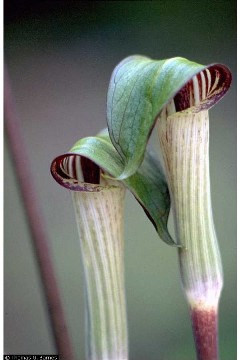Don't Mess with Jack
The jack-in-the-pulpit has developed
several adaptations to benefit itself.
One such adaptation is the presence of
poisons in its roots, leaves, and fruits.
The principle toxin is calcium oxalate, CaC2O4
and the roots also contain toxic levels of aspargines.  The
existence of these toxins discourages
predation, as the calcium oxalate crystals
found in the leaves create a burning
sensation upon chewing. It is even
suggested that should people with sensitive
skin handle a jack-in-the-pulpit, they ought
to wear gloves. However, this is not a
foolproof method of preventing predation as
deer will still eat parts of the plant.
The
existence of these toxins discourages
predation, as the calcium oxalate crystals
found in the leaves create a burning
sensation upon chewing. It is even
suggested that should people with sensitive
skin handle a jack-in-the-pulpit, they ought
to wear gloves. However, this is not a
foolproof method of preventing predation as
deer will still eat parts of the plant.
Other adaptations include methods to prevent self-fertilization. The primary means the jack-in-the-pulpit uses to do this is the sequential hermaphroditism the plant employs. Since most jack-in-the-pulpit plants are only male or female at a particular point in time, self-fertilization is not generally an issue. In the case of bisexual plants, the different amounts of time it takes for male and female flowers to mature will inhibit self-feritilization. Thanks to Tom Barnes of the University of Kentucky for the use of the picture!

Above, you can see a phylogenetic tree describing Arisaema triphyllum. It is based mostly on morphological traits of the plants, as well as genetic similarity to other plants. It begins with the kingdom Plantae, in which all plants fall. You will recognize many of these terms from the classification page. The second tier of the phylogenetic tree shows which subkingdom the jack-in-the-pulpit fits into. Tracheobionta is the subkingdom which describes all vascular plants, as mentioned on the nutrition page. Next is the superphylum, Spermatophyta. All seed plants fall into this category. From there, the tree goes on to the phylum Arisaema triphyllum belongs to, Magnoliophyta. All flowering plants are a part of Magnoliophyta. This terminates with the class the plant belongs to, Liliopsida. All plants that are a part of Liliopsida are monocots.

This second phylogenetic tree is less broad than the first one. It begins with the order Arisaema triphyllum is a part of. Since it belongs to Arales, this means the jack-in-the-pulpit is one of many plants that has a spathe and a spadix. Next is the family of the jack-in-the-pulpit, Araceae. This grouping indicates Arisaema triphyllum's possession of a corm. The jack-in-the-pulpit was placed in Arisaema because it lacks a woody stem. Once again, the actual species name is Arisaema triphyllum, indicating the plant's three-part leaves. Beyond this, there are even more divisions. The species is divided into four subspecies, although not everyone agrees with this division. The names given to these subspecies are A. triphyllum triphyllum, A. triphyllum stewardsonii, A. triphyllum pusillum, and A. triphyllum quintam. The "regular" jack-in-the-pulpit is defined as A. triphyllum triphyllum.
